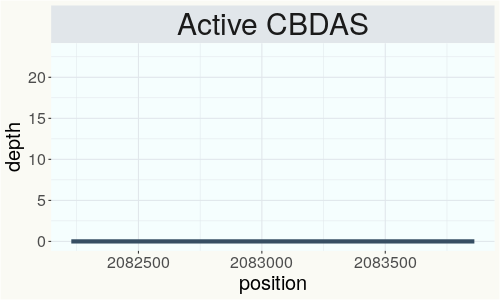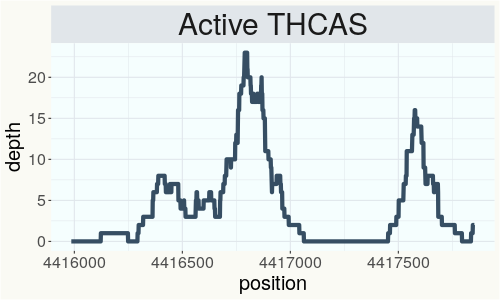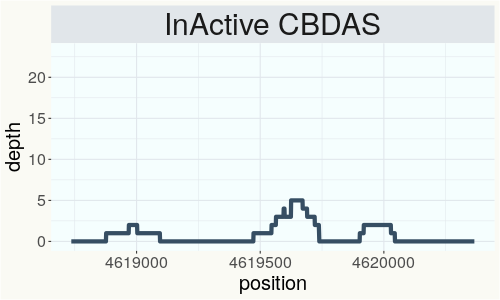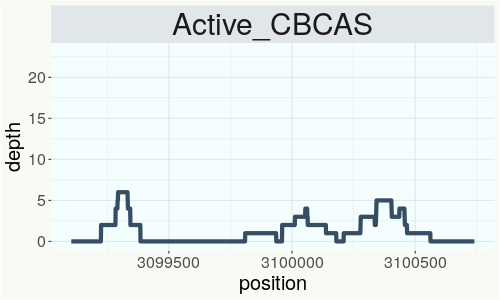Blue Dream
RSP 11010
Grower: QualCan
General Information
- Sample Name
- F20161104-05-1_01FEB2017
- Accession Date
- September 17, 2017
- Reported Plant Sex
- not reported
- Report Type
- StrainSEEK v2 3.2Mb
- DNA Extracted From
- Unknown
The strain rarity visualization shows how distant the strain is from the other cultivars in the Kannapedia database. The y-axis represents genetic distance, getting farther as you go up. The width of the visualization at any position along the y-axis shows how many strains there are in the database at that genetic distance. So, a common strain will have a more bottom-heavy shape, while uncommon and rare cultivars will have a visualization that is generally shifted towards the top.
Chemical Information
Cannabinoid and terpenoid information provided by the grower.
Cannabinoids
- THC + THCA
- 28.273%
- CBD + CBDA
- 0.046%
- THCV + THCVA
- 0.%
- CBC + CBCA
- 0.011%
- CBG + CBGA
- 0.246%
- CBN + CBNA
- 0.045%
Terpenoids
- α-Bisabolol
- 0.%
- Borneol
- n/a
- Camphene
- 0.007%
- Carene
- 0.%
- Caryophyllene oxide
- 0.%
- β-Caryophyllene
- 0.078%
- Fenchol
- n/a
- Geraniol
- 0.%
- α-Humulene
- 0.089%
- Limonene
- 0.042%
- Linalool
- 0.03%
- Myrcene
- 0.441%
- α-Phellandrene
- n/a
- Terpinolene
- 0.001%
- α-Terpineol
- n/a
- α-Terpinene
- 0.%
- γ-Terpinene
- 0.001%
- Total Nerolidol
- 0.005%
- Total Ocimene
- 0.007%
- α-Pinene
- 0.489%
- β-Pinene
- 0.131%
Genetic Information
- Plant Type
- Type I
File Downloads
The bell curve in the heterozygosity visualization shows the distribution of heterozygosity levels for cannabis cultivars in the Kannapedia database. The green line shows where this particular strain fits within the distribution. Heterozygosity is associated with heterosis (aka hybrid vigor) but also leads to the production of more variable offspring. When plants have two genetically different parents, heterozygosity levels will be higher than if it has been inbred or backcrossed repeatedly.
The ratio of reads mapped to Y-contigs to reads mapped to the whole Cannabis genome (Y-ratios) has been demonstrated to be strongly correlated with plant sex typing. This plot shows the distribution of Y-ratios for all samples in our database which were sequenced with the same method (panel or WGS) as this sample and where this sample falls in the distribution.

This chart represents the Illumina sequence coverage over the Bt/Bd allele. These are the three regions in the cannabis genome that impact THCA, CBDA, CBGA production. Coverage over the Active CBDAS gene is highly correlated with Type II and Type III plants as described by Etienne de Meijer. Coverage over the THCA gene is highly correlated with Type I and Type II plants but is anti-correlated with Type III plants. Type I plants require coverage over the inactive CBDA loci and no coverage over the Active CBDA gene. Lack of coverage over the Active CBDA and Active THCA allele are presumed to be Type IV plants (CBGA dominant). While deletions of entire THCAS and CBDAS genes are the most common Bt:Bd alleles observed, it is possible to have plants with these genes where functional expression of the enzyme is disrupted by deactivating point mutations (Kojoma et al. 2006).



This chart represents the Illumina sequence coverage over the CBCA synthase gene.

Variants (THCAS, CBDAS, and CBCAS)
No variants to report
Variants (Select Genes of Interest)
Nearest genetic relatives (All Samples)
- 0.003 Blue Dream (RSP11032)
- 0.004 Blue Dream (RSP11005)
- 0.006 Snoops Dream (RSP11003)
- 0.007 Blue Dream (RSP11007)
- 0.007 Blue Dream (RSP11033)
- 0.007 Blue Dream (RSP11227)
- 0.007 Blue Dream (RSP11006)
- 0.008 Blue Dream (RSP11008)
- 0.008 Snoops Dream (RSP11031)
- 0.008 Blue Dream (RSP11012)
- 0.009 Blue Dream (RSP11342)
- 0.011 Blue Dream (RSP11009)
- 0.011 Blue Dream (RSP11004)
- 0.015 Super Blue Dream (RSP11011)
- 0.019 Blue Dream (RSP11017)
- 0.085 Serious Happiness (RSP10763)
- 0.107 Doug s Varin (RSP11243)
- 0.131 Electra (RSP11366)
- 0.149 Domnesia (RSP11184)
- 0.152 Suver Haze (RSP11364)
Most genetically distant strains (All Samples)
- 0.412 Cherry Blossom (RSP11328)
- 0.409 BagSeed (RSP12627)
- 0.408 CS (RSP11208)
- 0.406 80E (RSP11213)
- 0.405 R3in134 (SRR14708220)
- 0.401 Feral (RSP10892)
- 0.399 Carmaleonte (RSP11207)
- 0.392 Feral (RSP11206)
- 0.392 Feral (RSP11205)
- 0.390 BagSeed (RSP12501)
- 0.390 80E (RSP11211)
- 0.389 IUP2 (SRR14708257)
- 0.389 Feral (RSP10891)
- 0.387 Beniko (SRR14708275)
- 0.387 Santhica 27 (SRR14708211)
- 0.385 R1in136 (SRR14708226)
- 0.385 Feral (RSP10890)
- 0.383 Ferimon 12 (SRR14708233)
- 0.382 Kush Hemp E1 (RSP11128)
- 0.380 Cherry Blossom (RSP11311)
Nearest genetic relative in Phylos dataset
- Overlapping SNPs:
- 34
- Concordance:
- 34
Nearest genetic relative in Lynch dataset
- Overlapping SNPs:
- 11
- Concordance:
- 11
Blockchain Registration Information
- Transaction ID
-
91864350afc193a0
ac86c3212783c439 635cd368539b95e5 738d4bdc3e578fa4 - Stamping Certificate
- Download PDF (870.7 KB)
- SHASUM Hash
-
df77d9ec3ae1c1ec2ea3818c6369029b bf4e6b8e160a35c0 2a8e7d442d4ea6f8